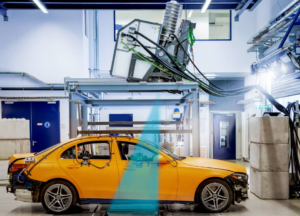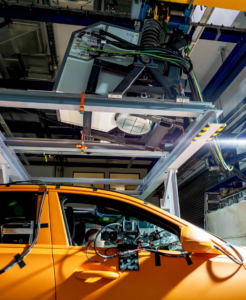
Mercedes-Benz performs X-ray of crash test, captures 100 images at impact
By onAnnouncements
Mercedes-Benz recently performed the first vehicle manufacturer X-ray of a crash test, a press release from the OEM says.
The X-ray device can capture 1,000 razor-sharp images per second and views details about injury and damage that have previously been unseen, the release says.
“In the milliseconds of the actual impact time, the X-ray system shoots around 100 still images,” the release says. “Combined into a video, they provide highly exciting insights into what happens inside safety-relevant components and in the dummy’s body during a crash. In this way, it is possible to observe in detail how the thorax of the dummy is pressed in or how a component is deformed.”
In partnership with Fraunhofer-Society, Mercedes used the X-ray camera to record a left-side impact on a vehicle carrying a female dummy at Ernst Mach Institute.
 “The Mercedes-Benz X-ray crash sets a milestone in the development tools of the future,” said Markus Schäfer, Mercedes board member and chief technology officer, in the release. “With a direct view into the hidden interior, it can help to draw important conclusions for the further improvement of vehicle safety. Mercedes-Benz thus confirms its role as a safety pioneer in automotive engineering.”
“The Mercedes-Benz X-ray crash sets a milestone in the development tools of the future,” said Markus Schäfer, Mercedes board member and chief technology officer, in the release. “With a direct view into the hidden interior, it can help to draw important conclusions for the further improvement of vehicle safety. Mercedes-Benz thus confirms its role as a safety pioneer in automotive engineering.”
The X-ray uses a linear accelerator with 1 kHz technology as the radiation source, the release says.
“The device is far more powerful than the X-ray flashes previously used in trials,” the release says. “The photon energy of the linear accelerator is up to nine megaelectron volts. This allows all materials commonly used in vehicle construction to be screened.”
It is able to record deformation processes without a blur, the release said.
“During the crash test, the beams shine through the bodywork and any dummies from above,” the release says. “A flat detector is located under the test vehicle. It serves as a digital image receiver in the X-ray system: When the radiation hits the detector, an electrical signal is generated. The intensity of this depends on how strongly the radiation was previously absorbed by the vehicle and dummy structure. This influences the grey value that is later visible – similar to the X-ray inspection of luggage at the airport or images of this kind taken by a doctor.”
The X-ray doesn’t affect any other analysis tools, such as the interior cameras used in the crash test, the release said.
EMI experts also created a plan to protect those performing the test, such as dosimeters for monitors and a concrete wall around the building, including a protection door.
“The successful X-ray crash provides us with valuable insights to further optimize our technology for capturing previously inaccessible information,” Dr. Malte Kurfiß, Fraunhofer EM head of crash test Center, says in the release. “Fraunhofer EMI is thus consistently pursuing its strategy of using high-speed X-ray imaging to make dynamic processes visible.”
The use of X-rays can also help the advancement of digital modeling, the release said.
Last year, the Insurance Institute for Highway Safety (IIHS) developed a virtual test to measure how seat and head restraints protect vehicle occupants.
Marcy Edwards, an IIHS senior research engineer, previously said in an article that digital modeling could one day make it easier to test various risk factors that are difficult to do with real-world crash tests. For example, modeling currently in development could perform a crash test multiple times with different body types.
A 2023 article from The Engineer, says modeling can be used to simulate a driver or passenger as a pregnant female body, an elderly body, or a child’s body.
“For elderly individuals, who usually have decreased bone strength and increased brittleness, virtual modeling can help understand the impact that the sudden inflation of an airbag would have on them in the event of a collision,” the article says.
It says modeling is able to replicate injuries to the musculoskeletal systems and organs in ways real-world testing couldn’t.
IMAGES
Photos courtesy of Mercedes-Benz

